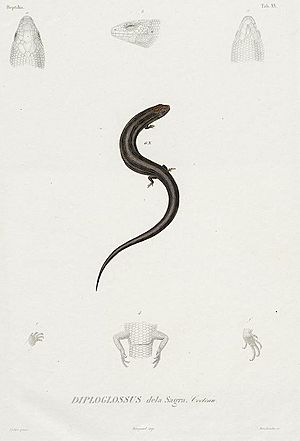Cuban galliwasp facts for kids
Quick facts for kids Cuban galliwasp |
|
|---|---|
 |
|
| Conservation status | |
| Scientific classification | |
| Genus: |
Diploglossus
|
| Species: |
delasagra
|
| Synonyms | |
|
|
The Cuban galliwasp (scientific name: Diploglossus delasagra) is a type of lizard. People in Cuba sometimes call it la culebrita de cuatro patas, which means 'the little four-legged snake'. This lizard is special because it is endemic to Cuba, meaning it's found nowhere else in the world.
Contents
What's in a Name?
The scientific name delasagra honors a Spanish botanist named Ramón de la Sagra. A botanist is someone who studies plants. This name was given to the lizard in 1838 by a scientist named Jean-Théodore Cocteau.
Where Do Cuban Galliwasps Live?
The Cuban galliwasp loves living in forests. But you might also find it in places where people grow fruit, like orchards, or on farms called plantations. These are its natural habitats.
What Does a Cuban Galliwasp Look Like?
This lizard is quite small for its group. Adult Cuban galliwasps are about 12 centimeters (about 4.7 inches) long from their snout to the base of their tail. They have short legs. Their back is brown, and their sides are dark brown or black. Their belly is a yellowish cream color.
How Do They Have Babies?
Cuban galliwasps are oviparous. This means the female lizard lays eggs, and the baby lizards hatch from these eggs.
See also
 In Spanish: Diploglossus delasagra para niños
In Spanish: Diploglossus delasagra para niños


